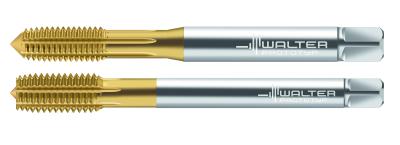
Walter has introduced the TC410 Advance HSS-E thread former, a versatile new TiN-coated threading tool that’s cost-effective even for small and medium batch sizes. It can be used universally for blind-hole and through-hole threads in most materials having a primary application in ISO material groups P, M and N and ISO K and S as a secondary application.
Key advantages for using the TC410 Advance thread former are superior performance, reduced torque and longer tool life thanks to new geometry and a post-treatment after the coating process. The post-treatment provides an extremely smooth surface on the tool. Having a smooth surface reduces friction between the tool and the workpiece and consequently the amount of heat generated. Minimizing the production of heat reduces wear and thus increases the useful life of the tool.
Walter offers the new TC410 Advance in two variants: With lubrication grooves for applications that need help getting coolant to the area where the forming is happening or without lubrication grooves for when the coolant is already pooled in the hole. Deeper threads up to 3.5 × DN can be produced in certain materials with these tools. Also offered are a wide variety of configurations covering thread styles, thread tolerances and shank standards, including an option for LH threads.
Its excellent price-to-performance ratio makes the TC410 Advance an attractive choice for users with medium to large batch sizes. This is because it can produce more threads with the same tool at a reasonable price. With its combination of productivity and cost saving features the new tool will find ready application in the automotive and energy industries along with general metalworking.
The Advance lineup of products is one of three categories to Walter thread formers: Advance, Perform, Supreme. The Advance tools are products which are efficiently balanced between price and performance. The Perform tools are products that provide an economical solution with focused importance on price. The Supreme designation indicates the highest level of technology and performance available.
Contact Details
Related Glossary Terms
- blind-hole
blind-hole
Hole or cavity cut in a solid shape that does not connect with other holes or exit through the workpiece.
- coolant
coolant
Fluid that reduces temperature buildup at the tool/workpiece interface during machining. Normally takes the form of a liquid such as soluble or chemical mixtures (semisynthetic, synthetic) but can be pressurized air or other gas. Because of water’s ability to absorb great quantities of heat, it is widely used as a coolant and vehicle for various cutting compounds, with the water-to-compound ratio varying with the machining task. See cutting fluid; semisynthetic cutting fluid; soluble-oil cutting fluid; synthetic cutting fluid.
- metalworking
metalworking
Any manufacturing process in which metal is processed or machined such that the workpiece is given a new shape. Broadly defined, the term includes processes such as design and layout, heat-treating, material handling and inspection.
- shank
shank
Main body of a tool; the portion of a drill or similar end-held tool that fits into a collet, chuck or similar mounting device.
- threading
threading
Process of both external (e.g., thread milling) and internal (e.g., tapping, thread milling) cutting, turning and rolling of threads into particular material. Standardized specifications are available to determine the desired results of the threading process. Numerous thread-series designations are written for specific applications. Threading often is performed on a lathe. Specifications such as thread height are critical in determining the strength of the threads. The material used is taken into consideration in determining the expected results of any particular application for that threaded piece. In external threading, a calculated depth is required as well as a particular angle to the cut. To perform internal threading, the exact diameter to bore the hole is critical before threading. The threads are distinguished from one another by the amount of tolerance and/or allowance that is specified. See turning.
- through-hole
through-hole
Hole or cavity cut in a solid shape that connects with other holes or extends all the way through the workpiece.







